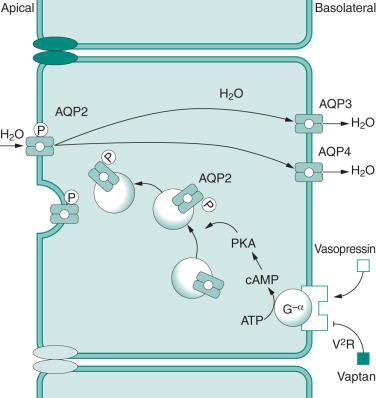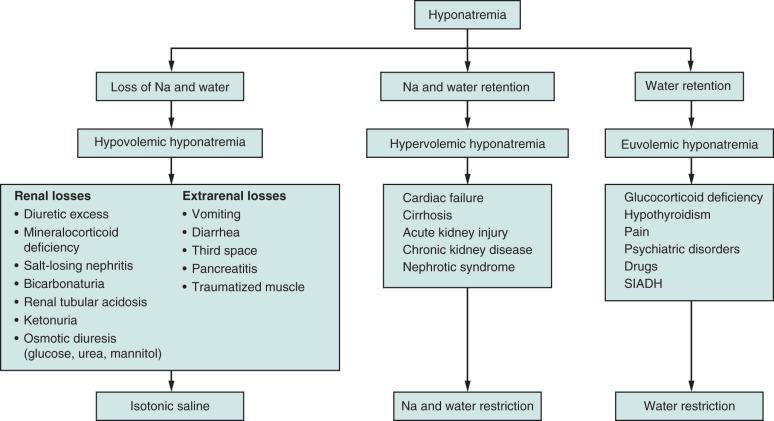Physical Address
304 North Cardinal St.
Dorchester Center, MA 02124
This chapter will:
Explain vaptan characteristics.
Review the diagnosis and management of hyponatremia.
Review vaptans for use in treatment of hyponatremia, especially with heart failure, cirrhosis, and syndromes of inappropriate antidiuretic hormone secretion.
Kidneys play an important role in maintaining homeostasis of electrolytes and water against large fluctuations of solute and water intake in normal conditions. However, maintenance of fluid homeostasis is frequently difficult, especially in hospitalized and critically ill patients, because of hormonal dysregulation, renal dysfunction, and inappropriate exogenous fluid administration. Diuretics are used widely to correct fluid accumulation that occurs unexpectedly in these patients. Because body fluids consist primarily of sodium and water, diuresis of two types is useful: natriuresis and aquaresis. Natriuretic agents act on several transporters or exchangers of electrolytes including Na+-K+-2Cl − transporter (loop diuretics), ENaC (thiazide), and Na+-K+ exchanger (potassium-sparing diuretics). Aquaresis targets free water reabsorption at collecting ducts that are regulated by arginine vasopressin (AVP). Recently, several agents that inhibit AVP (vaptans) have been developed for clinical use ( Table 62.1 ).
| TOLVAPTAN | CONIVAPTAN | LIXIVAPTAN | MOZAVAPTAN | SATAVAPTAN | |
|---|---|---|---|---|---|
| Administration route | Oral | Intravenous | Oral | Intravenous/oral | Oral |
| Receptor | V2 | V1a, V2 | V2 | V2 | V2 |
| V2:V1a selectivity ratio | 29.0 | 5.7 | 100 | 16.0 | 112 |
| Half-life (hr) | 6–8 | 14–17 | 7–10 | 1–8 | 14–17 |
| Metabolism | Liver (CYP3A4) | Liver (CYP3A4) | Liver (CYP3A4) | Liver (CYP3A4) | Liver (CYP3A4 CYP2D6) |
| Elimination | Feces | Feces | Feces | Feces | Feces |
Hyponatremia, defined as serum sodium concentration under 135 mEq/L, is highly prevalent in hospitalized patients and in intensive care units (ICU). It occurs in up to 30% of hospitalized patients. Hyponatremia is observed commonly in patients with heart failure, cirrhosis, nephrotic syndrome, and syndromes of inappropriate antidiuretic hormone secretion (SIADH). Although hyponatremia will be corrected by improving the causes of hyponatremia, hypertonic saline injection and water restriction are frequently necessary. Recently available vaptans are useful to correct hyponatremia.
Secretion of AVP, a peptide hormone of nine amino acids synthesized in the hypothalamus and stored in the posterior pituitary, is stimulated by increased plasma tonicity and decreased intravascular volume as a compensative reaction for water depletion. AVP receptors, which include three subtypes of V1a, V1b, and V2, are included in the large family of rhodopsin-like G-protein–coupled receptors ( Table 62.2 ). The V1a receptors are located in vascular smooth muscle cells, where AVP stimulates vasoconstrictive reaction. Clinically, AVP infusion has been applied in addition to norepinephrine for treating septic shock. The V2 receptors are located predominantly in the principal cell of the collection duct in the kidney and in vascular endothelium. AVP binding to V2 receptors stimulates the production of cyclic 3′, 5′-adenosine monophosphate (cAMP), which induces protein kinase A (PKA) activation to move aquaporin 2 (AQP2) contained in vesicles from intracellular space to the apical membrane. Then water permeates the cell through AQP2 at the apical and AQP3 and AQP4 at the basolateral membrane ( Fig. 62.1 ).
| RECEPTOR | LOCALIZATION | FUNCTIONS |
|---|---|---|
| V1a | Vascular smooth muscle | Vasoconstriction, myocardial hypertrophy |
| Platelets | Platelet aggregation | |
| Hepatocytes | Glycogenolysis | |
| Myometrium | Uterine contraction | |
| V1b (V3) | Anterior pituitary | ACTH release |
| V2 | Basolateral membrane of renal collecting tubule | Insertion of AQP2 into apical membrane, AQP2 synthesis |
| Vascular endothelium | von Willebrand factor and factor XIII release | |
| Vascular smooth muscle | Vasodilatation |

Vaptans, nonpeptide AVP receptor antagonists, excrete electrolyte-free water by inhibiting AVP binding to its renal receptors (V2) irrespective of sodium excretion. Aquaresis, which removes excess amounts of free water with no sodium excretion, can be achieved by vaptans. Vasopressin antagonist penetrates deeply into the basolateral cell membrane and docks the binding site that partially overlaps the AVP-binding site. Vaptans compete with AVP for V2 receptor-binding site and prevent this sequence of events so that water is not reabsorbed. Several vaptans are clinically available for diseases of different types (see Table 62.1 ).
Hyponatremia has some undesirable characteristics in the ICU patients. For instance, hyponatremia is a common cause of delirium in the ICU. An odds ratio of 8:2 for delirium in patients with hyponatremia has been reported. Hyponatremia is also a strong prognostic factor for patients with heart failure and cirrhosis. Several studies have demonstrated that mortality and length of ICU stays are increased in ICU patients with hyponatremia. Therefore appropriate management for hyponatremia is expected to improve the outcomes of critically ill patients in the ICU.
Hyponatremia, a heterogeneous disorder that results from sodium and water imbalance, is categorized into three different types: isotonic, hypertonic, and hypotonic. Among them, most ICU patients with hyponatremia show hypotonic hyponatremia. Evaluating the total body sodium and extracellular fluid volume status is necessary for the diagnosis and treatment of hyponatremia ( Fig. 62.2 ). Several disorders can cause hyponatremia, thereby reducing the dilution capacity because of the continued secretion of AVP in spite of the presence of serum hypo-osmolality and intrarenal factors, such as a decreased GFR or proximal tubular fluid and sodium reabsorption.

Become a Clinical Tree membership for Full access and enjoy Unlimited articles
If you are a member. Log in here